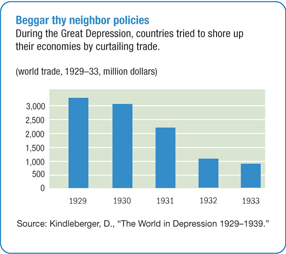Cooperation and reconstruction (1944–71)
The multimedia content on this page cannot be printed.
Video (2:38): A new era of economic cooperation began in Bretton Woods, New Hampshire in 1944
During the Great Depression of the 1930s, countries attempted to shore up their failing economies by sharply raising barriers to foreign trade, devaluing their currencies to compete against each other for export markets, and curtailing their citizens' freedom to hold foreign exchange. These attempts proved to be self-defeating. World trade declined sharply (see chart below), and employment and living standards plummeted in many countries.
This breakdown in international monetary cooperation led the IMF's founders to plan an institution charged with overseeing the international monetary system—the system of exchange rates and international payments that enables countries and their citizens to buy goods and services from each other. The new global entity would ensure exchange rate stability and encourage its member countries to eliminate exchange restrictions that hindered trade.

The Bretton Woods agreement
The IMF was conceived in July 1944, when representatives of 45 countries meeting in the town of Bretton Woods, New Hampshire, in the northeastern United States, agreed on a framework for international economic cooperation, to be established after the Second World War. They believed that such a framework was necessary to avoid a repetition of the disastrous economic policies that had contributed to the Great Depression.
The IMF came into formal existence in December 1945, when its first 29 member countries signed its Articles of Agreement. It began operations on March 1, 1947. Later that year, France became the first country to borrow from the IMF.
The IMF's membership began to expand in the late 1950s and during the 1960s as many African countries became independent and applied for membership. But the Cold War limited the Fund's membership, with most countries in the Soviet sphere of influence not joining.
Par value system
The countries that joined the IMF between 1945 and 1971 agreed to keep their exchange rates (the value of their currencies in terms of the U.S. dollar and, in the case of the United States, the value of the dollar in terms of gold) pegged at rates that could be adjusted only to correct a "fundamental disequilibrium" in the balance of payments, and only with the IMF's agreement. This par value system—also known as the Bretton Woods system—prevailed until 1971, when the U.S. government suspended the convertibility of the dollar (and dollar reserves held by other governments) into gold.
- Who we are
- Statutes and Decisions
- Evaluation and Audit
- Corporate Citizenship
- More Resources
